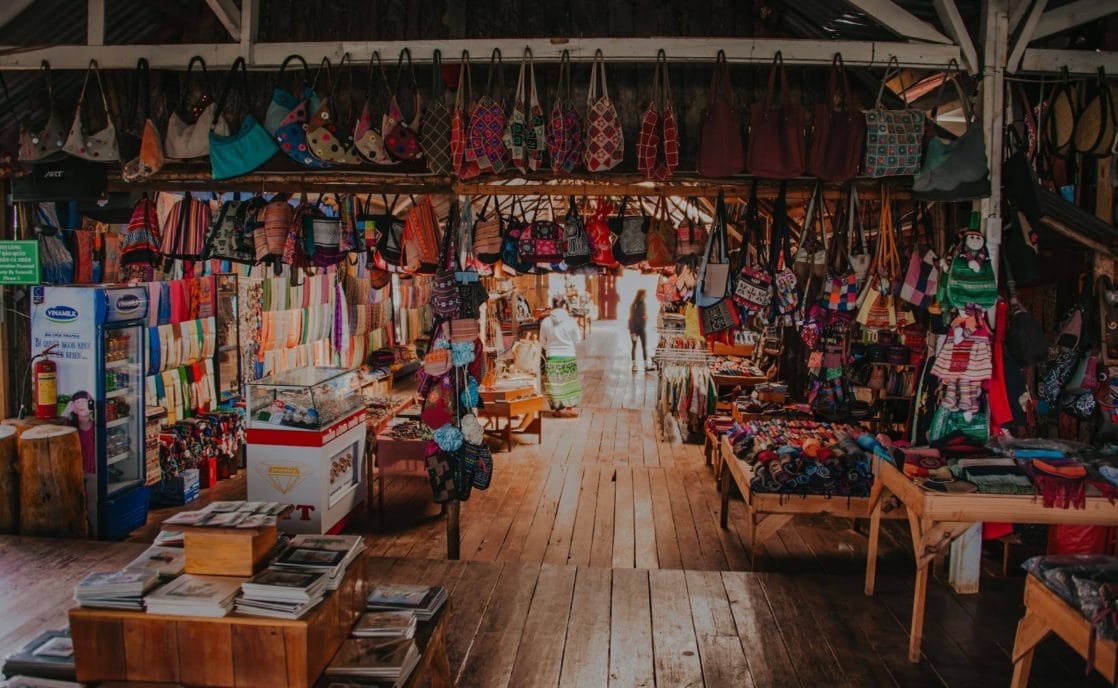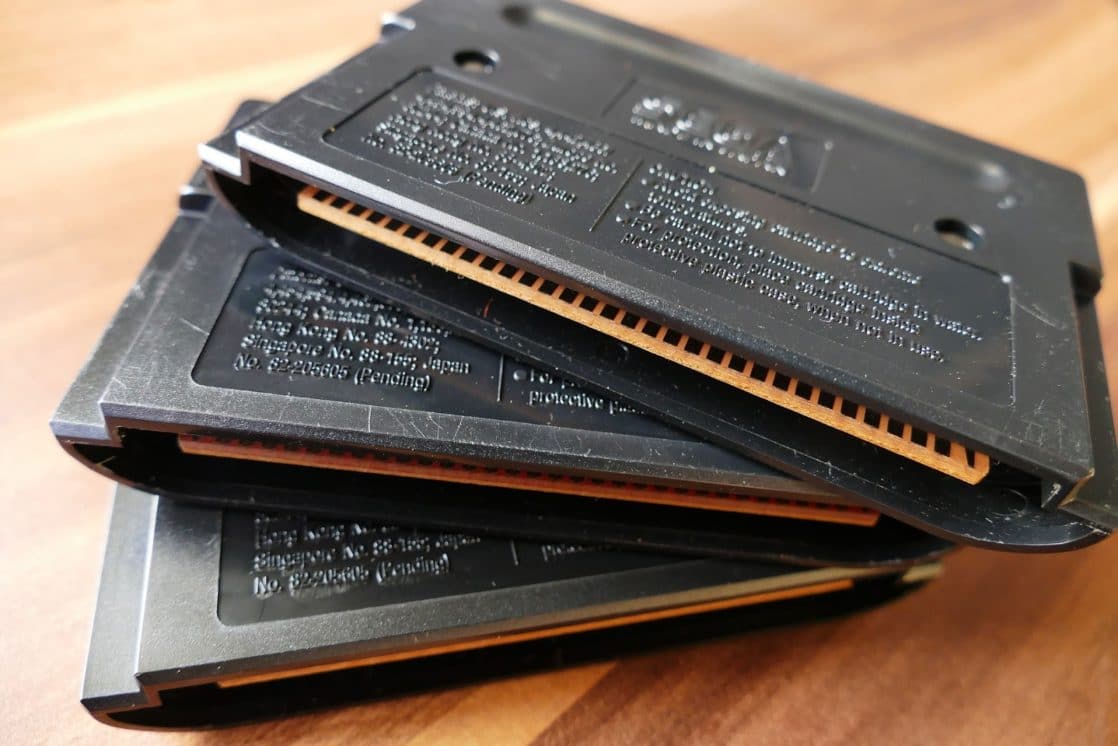
If you’re here, I think we can agree that you’re interested in using thrift stores to buy and sell products online.
Great! We want to talk about that.
But you should know there’s a lot of “fluff” out there on the web around this topic.
Or, stuff that dives too deep into things you don’t care about without providing much in actually actionable steps — that stuff tends to be lazy and easy to write.
We want you to be able to get started today, while knowing what you’ll need to do later on — so that’s what we aim to do with this guide.
Table of Contents
Why an eCommerce “thrift” Store

Well…
When you’re choosing a business model, taking a look at trends and markets that are showing upward growth is important — and eCommerce (online selling) is a growing industry. In 2017, eCommerce sales reached $2.304 trillion, a 24.8% increase from the previous year.
And while traditional storefronts require staffing, rent, etc., which eat into profit and limit selling-hours, an online store allows you to keep more of that profit and have product available to sell at all hours, even when you’re asleep.
The used-merchandise industry — otherwise known as thrift, resale, consignment or “flipping” — is also a big one — to the tune of about $17 billion a year in the U.S. alone.
But despite that impressive number, profit on brick-and-mortar thrift stores is fairly low. Although in great part that is because of non-profit status by most true thrift stores, the other part is typically because of the costs we mentioned above (rent + staffing).
So… take that $17 billion-a-year industry, pair it with eCommerce, and what do you get?
The perfect marriage of low staffing, rent, and around-the-clock selling, and a piece of a lucrative industry.
Before you continue
Just want to make something clear: starting an eCommerce business is not for everyone. The potential of this pairing does not make it a get-rich-quick scheme — it’s still a business and requires work. If you need money fast, need a guarantee, aren’t willing to make sacrifices elsewhere, or aren’t web savvy or willing to learn — this isn’t the route you should take.
Getting started — but first, how to source

So you want to learn more about starting your own online business, and we haven’t scared you away.
Before we dive into the 1-2-3-4, let’s talk about how to “source” items to sell in your store.
Sourcing inventory… where the hell do I look?
As you saw in our headline, one place you can start looking to “stock the shelves” (whether literal or figurative — a closet in the spare bedroom works too) is big-name thrift stores like the Salvation Army, Goodwill, etc.
Since the title says Salvation Army, we’ll primarily talk about tips to get the most out of sourcing from actual thrift stores. Sourcing your inventory this way is fine, but we’ll also discuss some other, potentially more lucrative, ways you can get items to sell.
Some other places you can check out:
- eBay
- Craigslist
- Garage sales
- Storage unit auctions
- Estate sales
- Manufacturer overruns
- Liquidation sales
- Clearance sales
- Online auctions of bulk items
- Wholesales (brick-and-mortar or online)
- Church rummage sales
- Flea markets
- Ads you place looking for specific items…
The list can go on. The important thing: you can find stuff everywhere, if you look hard enough. And most people don’t know the value behind what they have.
What To Do: Sourcing at Thrift Stores
While these tips are great for hunting at brick-and-mortar thrift/resale stores, they really apply to all the other sources listed above, too.
-
Check online before you buy
Use your smartphone to check out prices before you buy. eBay sellers tend to have a good idea of what items are worth, so it’s a good place to use as a baseline to see if you can make a profit.
-
Check for markings.
Looking at some pottery or jewelery? Check for markings stamped in. For INSTANCE, the older, more valuable Pyrex glassware has all capital PYREXⓇ, as opposed to newer Pyrex, which is lowercase (pyrexⓇ).
-
Shop high-end locations
Higher-end neighborhoods tend to have higher-end items, so they’re good areas to check out potential sources.
-
Use discount days at thrift stores.
Keep an ear to the ground for discount days at your local thrift stores. Because of donations, brick-and-mortar thrift stores need to rotate their inventory through frequently — meaning they need to get items out the door. So, discount days can help you nab decent goods to sell for better profit.
-
Clean up your hauls
Make sure your finds are clean or cleanable before investing in them. Check for stains or smells, and skip items of clothing or furniture that need more than a wash or lint roller. Glass, ceramic, or silver might require some polishing before selling — but always compare your finds to similar items online. Some sell better without a polish.
-
Keep shipping costs in mind
Depending on where you look and what you buy, margins can still be slim, so remember to think about shipping costs. The heavier, bulkier, or more delicate the item, the more shipping will cost you. Make sure it will ultimately be worth it.
Traditionally, Items That Sell

- Books + textbooks (especially sets)
- Picture frames
- Video games
- Brand clothing, clothing sets, or anything with the tag still attached
- Pyrex and glassware
- Sporting equipment
- Records + record players
It seems like people are always looking for these kinds of things.
How to Create an Online Thrift Store
Now, with some background and ideas, let’s go beyond sourcing and jump into the specific steps of starting your business (finally!).
1. Pick & Research Your Niche
This goes for all eCommerce, but it’s still applicable here. Obviously, your niche is ‘thrift/resale’, but you may still want to narrow it down further.
And even if you don’t, the things below still apply, with the big takeaways being to research your target market and target customer — if you know what they want to buy and how to attract them, half the battle is won.
Market size
Niching down allows you to increase your profit by serving a smaller, specific group of people — but there still needs to be a market. If you go too narrow, it’ll be harder to find customers and expensive to acquire them, which will limit your growth and revenue.
Using Google’s Keyword tool can help you find out how much search volume there is for a given product (or type of product) or market (like baby dolls from 1920-1950), which can help you see if there’s a demand, which in turn can help you decide if it’s worth focusing on.
Competition
What kind of competition is out there already in the market you’re looking at? If there are a lot players already in your niche, that may be a sign of two things:
A. The market has been validated (great!), but;
B. In order to break through, you’ll have to do something different to attract customer attention.
Google’s keyword tool is helpful here, too to find this out.
Trend, fad, or growing market
Pretty self-explanatory: does your chosen niche fall into the category of a fad, a trend, or a growing market? Google Trends tool can help you here.
Target customer
If you’re thinking “thrift” store, chances are you have a target customer in mind already. You don’t have to go super in detail yet, but you need to be aware of the type of customer you’re trying to sell to, as it will influence all your marketing later.
Markup
How much higher can you sell an item for than you bought it? In resale, that will likely vary, even if you specialize in a narrow selection of items.
Unlike in selling new products, where you can figure out how much it costs to manufacture/buy every time, then mark it up to a profit, due to thrifting’s nature, this is more variable.
Selling point
Going alongside the last point, how much can you sell the item, or type of items, for? Again, niching down can lead to greater profit, but alongside demand, you need to be able to sell it for a high enough price to make it worth it.
2. Set Up Your Location
Although one advantage of not having a physical storefront is that you can cut down rent costs, you still need somewhere to sell your items from.
While you can always start out on a website like Craigslist or Letgo, eventually you should think about starting a website to sell directly from.
There are a few options you can pick from, with various pros and cons:
Self-hosting your own website
Pros: -You own everything. -You have more control over features and customization.
Cons: -Requires some technical expertise. -Takes more to setup. -Costs more than other options to set up. -You’re on your own — no or little tech support.
Hosted platforms
Pros: -Built-in hosting, speed, and security -Customer support -eCommerce-specific features -Marketing tools -Pre-made + customizable design themes to pick from
Cons: -Pricing: -Monthly price -Platform transaction fees -Credit card fees -Add-on features fees -Less control over features/customizing, or paying more to do so
Online marketplaces
Pros: -High traffic channels, helping you acquire new customers (especially if you have a website) -Many online consumers prefer shopping via marketplaces.
Cons: -Marketplace fees -Limited control — you’re selling in front of someone else’s yard. -Keeping inventory in sync.
Ultimately, how you choose to set up your online location is a personal choice. If you’re tech savvy, building and self-hosting your own website may appeal to you. If you want a more done-for-you solution, using an eCommerce platform might be the right choice.
And if you want to skip a website entirely for a while, marketplaces can help you do that.
But, one thing to remember is that it doesn’t have to be an either/or situation, either. Starting a website –whether self-hosted or on a platform — can be done alongside using marketplaces. In fact, this can be a very good way to build awareness for you online thrift store and acquire customers, for the reasons mentioned above.
If you’d like to see more comprehensive reviews of platforms like Shopify or BigCommerce, you can check some excellent ones out here and here.
3. Build Your Inventory
So — you’ve got your niche or market figured out and you’ve got your virtual storefront set up. Now what?
Take those tips above and start sourcing!
Get started at thrift stores. Or, if it’s yard sale season, grab your cash and go hunting.
Keep in mind the other sources we mentioned, as well: storage unit auctions, clearance sales, estate sales, etc. If you’re feeling confident (or desperate — it can be a fine line.), dumpster diving can be another place to check, as things thrown away often need only minor repairs to be sellable.
Storing your inventory
Ideally, once you have your site set up and you’ve begun to bring home finds to sell, you’ll be listing new ones every day — but you still need somewhere to store them before in the meantime.
So what are your options?
Storing at home
This is a good first option when you’re just starting out. Clear out a large closet, side room, your living room, your bathroom… Eventually, you’ll outgrow this, though, especially if you’re meeting with solid success. Then it may be time to…
Rent storage space
“But StartupBros! You said we could save on the biggest expense of traditional thrift stores! What gives?!” I know, I know. We said that.
And we’re standing by it: renting storage space is cheaper than renting and keeping a whole store. Whereas storefronts have many other expenses, when you rent a storage space that’s all you’re paying for.
Sure, some have security systems or climate control, but that’s factored in and still winds up cheaper than an entire store.
Side note: have a system
While we’re on the topic, let’s talk about a few common problems with managing your inventory.
Overstocking
All overstocking means is that you have merchandise taking up shelfspace, tying up capital that could be better spent on things that sell quickly.
You don’t want to be overstocked — you aren’t stuffing Christmas stockings.
You also risk winding up with things that don’t sell. If you bought it and no one wants it, you may wind up with this problem.
Understocking
The flip side of overstocking, you wind up with extra cash, but not enough inventory. This probably won’t become a problem until you start getting consistent or repeat customers.
The solution for both these problems is to do your research before buying — both the item and your market.
Is your target market looking for this sort of item? If they aren’t now, will they in the future? Will it sell at a high enough margin to make you a profit?
Lost/disappearing stock
There are multiple ways you can keep track of your inventory.
The first (and arguably most prone to error) is to keep track manually with spreadsheets or pen and paper. This way is doable, but can take a lot of time and energy to input every order and keep up-to-date.
Another way, if you go with a hosting platform (Shopify, BigCommerce, etc), is to use their automated management system. This works really well — if you sell primarily through one channel. So if you decide to sell on marketplaces as well, you’ll have to keep a separate system — so it’s not really centralized.
Finally, you have an eCommerce inventory management system, designed specifically for eCommerce.
It allows you to upload your sales and inventory to your website from all your channels. Most also include automated order fulfillment and inventory quantity updates. Of these options, this is the only true centralized system — and the one to go with.
Here’s a good video that explains inventory management really well:
4. Create & Execute a Marketing Plan
Finally — the last step: marketing your business. Even if everything else is perfect — your website looks great and functions well, your products are well-researched, beautifully photographed, and posted at the perfect price-point — without marketing, traffic and sales will be slow to come.
We won’t go in depth today, but here are the basic things to include in your marketing plan and some extras at the end:
Optimize your site for SEO
Search Engine Optimization is a technique used to make it easier for search engines like Google and Bing to find your website. If your site is optimized to be found, you increase your likelihood of being a top search result when potential customers type in related search terms.
Sprinkle related keywords throughout your website, and set up your posts with headlines that optimize for SEO. Speaking of posts…
Start and maintain a blog
Keeping a regularly-updated blog on topics that your target audience is interested in is another way to promote your business and draw in traffic. We’ve got a great article here on how to do this, and another one on making posts go viral.
For today we’ve got two things to remember, especially if you’re feeling shy about starting a blog: write the way you talk about things you’re audience is interested in; and regularly doesn’t have to mean everyday or even every week.
If you’re posting once per month, every month, you’re posting regularly and staying updated. Google loves this, too.
Participate in relevant forum discussions Someone on Quora has a question about antique chairs and your big money-maker is just that? Give them a great answer and include your website’s URL in your signature.
Do this regularly (there’s that word again) and you’ll be getting your website in front of your target market.
Use social media
Create a page for your business on social media platforms, like Facebook, Instagram, Twitter, etc. and post regularly (are you seeing a theme?). Invite friends, family, and customer to ‘Like’ or ‘Follow’ your business.

You can use Instagram to showcase your what you find at the thrift stores!
The Instagram 4-Week Hustle (10K Instagram Followers in 4 weeks)If you just bought something special and listed it, or your just posted a new blog article, share those links on your page. Social media can be a great virtual word-of-mouth platform to reach and build an audience and customer base.
Extra: Use Amazon and eBay marketplaces
We touched on this earlier, but it’s worth mentioning again. Using marketplaces like eBay and Amazon can be a good channel not only to make sales, but to attract customers to your website for future shopping.You pay fees, but you reach a larger customer-base in exchange.
Extra: Pay-Per-Click (PPC) ads
Finally, although optional, you can invest in PPC ads. These targeted ads appear at the top of search result pages. A little more expensive option, as every time a prospect clicks on the ad, you pay a small fee. But, if you make a sale off this click, it can be worth it.
Bonus tips
By this point, you’ve learned a lot, but probably still have some questions. To that end, here are some bonus tips: If you don’t have much/any money to get started…
If you want to start your online thrift store but are a little low on funds, there are a few things you can do to still get started:
- Start with what you have. Go through your home and collect anything you have that’s in good condition and no longer used or needed. If you have family or friends that are willing, ask them if you can go through their things, too.
You don’t need much to start making sales, and you probably have more than you realize that you can sell to build up some funds.
- Order your free mailing supplies. If you live in the United States, the United States Postal Service will send you free mailing supplies. The only catch is it has to be priority or priority express mail (i.e. weighing at least 16 ounces up to 70 pounds).
- Start out on eBay. Becoming an eBay seller can be a good way to start selling if you can’t afford to start your own website just yet. While you do have to pay a fee when you make a sale, eBay only takes their cut once per month — not up front.
Setting yourself up for success… Set a schedule — when will you source? When will you clean up items, take photos, and list? When are you going to manage your inventory? Execute the tasks in your marketing plan?
It pays to check out your local thrift stores to get an idea of their schedule. When do they put out new inventory? When do they run sales? This is useful for sourcing and for getting ideas for your own schedule.
Finally, some general, “best practice” advice:
Be honest
Don’t take pictures that hide large (or even small) flaws. It’s your — and your business’s — reputation on the line. Likewise, even if the item is in excellent condition, your buyers will want to know that, too.
Being up front about the condition can help reduce returns and refunds, as well, which eat into your profits.
Use as many high-quality photos as possible
Using 7-10 high-quality photos can help provide more visibility and credibility to your prospects, according to Heidi Ferguson, a well-established seller of Vintage items.
An extra tip: check the item’s listing out from multiple different electronic devices to make sure it looks good across a wide range of devices.
Also: never copy-and-paste a photo of a similar item off Google images. Even slight differences can cause trouble with your customers.
Watch your margins
Remember this mantra: “Buy low, sell high.”
When sourcing, always research before buying. Once you start getting a flow of items and cash in and out, track your revenue to keep an eye on your profit margins. Work on widening the narrow ones.
Confirm payment before shipping
This one may seem obvious, but making sure payments clear before you ship is a must. Not everyone is trustworthy, and trying to get recompense after the fact is a long, uphill battle.
The end — and your beginning
Whew! You made it! You should have enough to get started building your online thrift store now. If you need more help, click on the ‘Let’s Work Together’ tab and let’s talk.

I really love this article
In my opinion olx and myyook are good for selling things
Hey Sonia, thanks for checking out the article. We’ll have to look into those websites, so thank you for the resources.
Thanks for educating us.Am a 50yrs old grandmother who lives in Abuja Nigeria. I want to start my mini thrift store. I need your help on how,where and when to buy. I have some philatelic stamps and clothes to start but I don’t know how. I need to write a business plan. Please I need all the help you can give me. Thanks Will.
Thanks for checking out the article 🙂 First let me ask, why do you need a business plan? What is the goal you’re trying to accomplish?
Love this post. Will test the waters.
Awesome! Let me know how it goes 🙂
Most informative and useful article I have seen. Thank you!!
Thank you for the information it was helpful to me. I am excited for my future business to blossom in the gift god design it to be. you have bless me with great insight. I truly thank you Will Mitchell
Will, Thanks for sharing the insightful article on how to find vintage or forgotten Items and start a booming online thrift store… I’ve been searching for this techique for long and your article just fulfilled my desire.
John? Don’t you live in the Orlando area? You use to work at Big Apple Consulting?